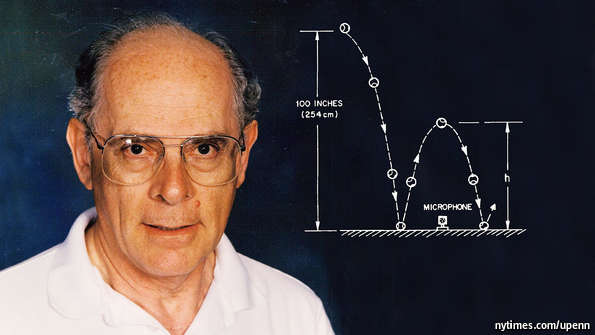
DID Isaac Newton play tennis? He certainly liked to watch it, for as he first observed light rays bending in and out of his prism, in 1666, “I remembered that I had often seen a Tennis ball, struck with an oblique Racket, describe such a curve line.” His three laws of motion, too, as Howard Brody liked to point out, make a pretty good synopsis of a game of tennis: 1, An object in a state of uniform motion will remain in that motion unless it encounters an external force; 2, force equals mass times acceleration; and 3, for every action there is an equal and opposite reaction (unless the ball goes out).
Professor Brody’s love of tennis, perhaps like Newton’s, was never quite matched by his skill. From fumbling tournaments in high school (“The coach gave up”), he progressed to four years of varsity play at MIT, and for one heady month coached the men’s team at the University of Pennsylvania where, for almost all his career, he was a physics professor. His original field, though, was particle and nuclear physics, the result of a boyhood fascination with a little book called “Atoms in Action”; and it was only by a fortuitous piece of topspin, or backspin, or rotation about an axis, that he found himself focusing not on photons and quarks but on relatively massive fluffy yellow balls, bouncing.
From his office at Penn he could see the courts, and on holiday he made for them; and around the mid-1970s he noticed that racket heads were getting bigger. Were they therefore better? As he tried to find out, to his surprise, an almost unexamined branch of science opened out before him. The timing was good, for after a stint at CERN in Geneva he was tired of being just one more PhD in a crowd. True, his kudos took a bit of a dive between working on the Large Electron-Positron collider and pitching balls at a racket hung on a string, or dropping them from a stepladder, in a Heath Robinson way. (One footnote read, “It was suggested that the author not rip out the tiles for the purpose of performing this experiment.”) But it was a lot more fun.
Within a few years he found himself the world authority on the elasticity of strings, the “dwell time” of balls on them, ball trajectories, windows of acceptance (the gap between the minimum angle needed for the ball to clear the net and the maximum that allowed it to stay inside the baseline), twistweights and sweet spots. In 75 articles he laid out his findings, with copious graphs and equations. He became an adviser to the Professional Tennis Registry and the International Tennis Federation, among others. Not as much time was spent on court as he might have liked, since oscilloscopes and simulators worked better indoors. But he jauntily turned up to meetings and dinners in tennis shoes, just the same.
His chief satisfaction was that ordinary players could profit from his work. His academic articles ruefully conceded that ordinary Joes and Janes, standing by the racket display in Dick’s Sporting Goods, might not have a torsional oscillator to hand. So in 1987 “Tennis Science for Tennis Players” laid out his findings for those for whom “dwell time” means sitting under a towel eating a banana; a “polar moment of inertia”, the realisation that the ball is heading for the neighbour’s window; and the “apparent coefficient of restitution”, the hope that he will still chuck it back.
Finding sweet spots
Players mostly wanted to know how tightly they should string their rackets. Professor Brody’s advice was, not as tightly as they thought they should. Looser strings (not too loose, though; “a butterfly net would clearly be no good”) conserved more of the energy fed to them by the ball, deformed themselves more and deformed the ball less. For the same reasons, better elasticity and a little roughness, gut strings were better than synthetic ones. On the other hand, stiff frames, which vibrated less, played better than the flexible kind. As for sweet spots, where the player barely felt the impact of the ball, Professor Brady found that there were in fact three per racket, tantalisingly close together. A wider head made the sweet area more central, allowed more room for topspin and reduced the risk that a miss-hit would make the racket twist in your hand. So yes, a Prince Thunder Bolt would play better than a Spalding Smasher—in theory.
In practice, as he admitted, an awful lot still depended on how good the player was. Side-by-side video clips of himself and Roger Federer showed no difference in the physics, but rather a lot in the physique. No one had yet analysed ball control either on court or in the lab—though, without it, sheer power was not much use. The science of swing was still under investigation. The grip of a hand on a racket, he had found in one of his favourite experiments, added almost nothing but steering. For that matter, no one had worked out the biomechanics of tennis elbow, either.
He had, however, a little list of tips for avoiding unforced errors and improving technique. Don’t change the ball angle on the return; don’t hit the ball too hard; when serving, hit the ball as it’s falling; and add lots of topspin, giving gravity a helping hand to curve the ball downwards. It was topspin, of course, that Newton had admired. In short, Professor Brody concluded, players had to obey the laws of theuniverse. Simple, really.
